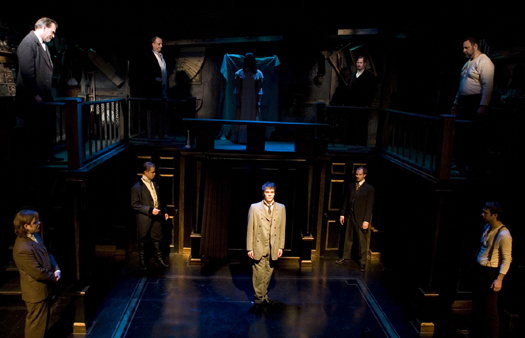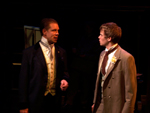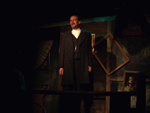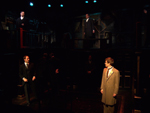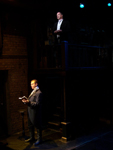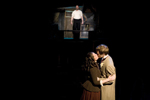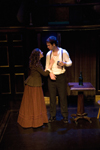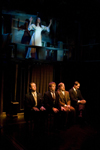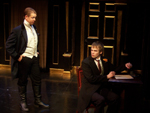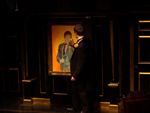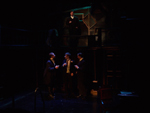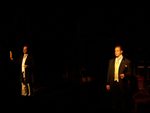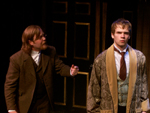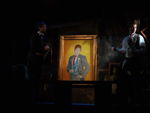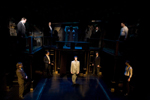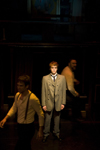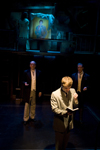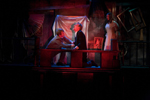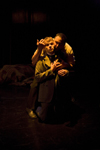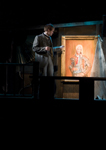From the Chicago Sun-Times
Wilde’s tale of Faustian deal is bargain at Lifeline
September 24, 2008
By Hedy Weiss
Highly Recommended
“The Picture of Dorian Gray” is Oscar Wilde’s Faustian tale of a beautiful young man in Edwardian high society who makes a bargain with the devil. After exchanging his soul for the promise of eternal youth and unfettered experience, Dorian embarks on a life of total narcissism and depravity, leaving all those who love or befriend him either broken or dead, and realizing far too late he also has destroyed himself.
Of course with Wilde you can be sure the aphorisms fly with the speed of light, providing witty (and withering) commentary on everything from love, marriage, power and truth to art and death. But beneath the slashing brilliance and cynicism of Wilde’s observations there also is a deep ruefulness and pain that can catch you by surprise.
Lifeline Theatre’s new production of “Dorian Gray” is enthralling, with a crystal-clear, ideally structured adaptation by Robert Kauzlaric; thrilling, sinuously choreographed direction by Kevin Theis, a gilt-edged black set by Tom Burch, and a remarkably fleet, stylish cast.
Of course without a perfect Dorian — a man whose beauty is both distancing and magnetic, and whose odd emotional detachment creates an ideal self-reflective surface for the desires of others — the story cannot work. With his graceful figure, and a face that hints of the young Rudolf Nureyev and Mick Jagger, actor Nick Vidal not only is physically perfect for the role, but has tapped into the strange mix of charisma and blankness essential to carrying it off. His performance could not be more alluring or assured. And he is surrounded by a brilliant ensemble.
The conceit in Wilde’s tale is that Dorian never grows visibly older. Instead, the scars on his soul pile up on the surface of the grand portrait (a sensational canvas by Charlie Athanas) painted in his most golden young manhood. Those characters who interact with Dorian over the years DO age, and are double-cast.
Particularly seductive and satanic is Wilde’s alter ego, the married bisexual aristocrat Lord Henry Wotton (Paul S. Holmquist and Sean Sinitski are riveting as the younger and older man, respectively). The adoring painter, Basil, is deftly limned by Aaron Snook and Don Bender, while Kyle A. Gibson and John Ferrick as Dorian’s early love, Alan. Melissa Nedell is touching as the poor, vulnerable actress Dorian brutally abandons in this haunting cautionary tale.
From Centerstage
September 26, 2008
By Colin Douglas
Robert Kauzlaric’s world premiere that kicks off Lifeline’s 26th season of literary adaptations is a brilliant, faithful adaptation of Oscar Wilde’s late Victorian gothic horror novel. The story examines a man’s obsession with youth and physical beauty. It also offers a twist on the Faustian theme, features a cautionary lesson about hedonism and is filled with instances of decadence and homoeroticism.
Director Kevin Theis has assembled a most talented ensemble of actors and designers who deftly breathe life into this mesmerizing tale of a man bewitched and tormented by his own desire. The playwright cleverly balances the younger with the elder versions of four key characters: Basil Hallward, the artist who adoringly paints Gray’s portrait; Lord Henry Wotton, the nobleman who both befriends and then corrupts Dorian with his view of the world; Alan Campbell, once a close friend smitten with Gray until his reputation begins to come into question; and James Vane, the overly protective brother of the woman Dorian’s promised to marry. By sometimes juxtaposing their dialogue, often positioning the elder version of the character on the set’s upper level directly above the younger version, the director creates an interesting comment on maturity and aging.
The entire cast is accomplished and fully in charge of this briskly paced production, making it difficult to cite any one actor. However Nick Vidal is positively riveting in the title role and his gradual degeneration toward depravity is both subtle and profound. With merely a sideways look or the lift of an eyebrow, this actor can speak volumes. And without spoiling the effect, suffice it to say that once you’ve experienced the play’s heart-stopping final moments, you’ll develop an appreciation for this young actor, as well as the unity of this ensemble of actors.
Aaron Snook and Don Bender both play Basil, the artist whose fervent love for Dorian Gray’s beauty is destined to bring about his downfall. Both Paul S. Holmquist and Sean Sinitski deliciously serve as Oscar Wilde’s mouthpiece sharing the play’s best and wittiest lines as hedonist Lord Henry. Kyle A. Gibson and John Ferrick share the role of Alan Campbell, showing the character’s love turn to horror as Dorian ultimately betrays him. Melissa Nedell is haunting as Dorian’s love interest, Sibyl Vane, particularly in the moments unspoken.
Technically this production is superior to most. In the intimate little Lifeline Theatre, the two-level set works well, utilizing the balcony level as Gray’s attic as well as the place where memories live, while the ground floor depicts the here and now. The special effects are particularly well-done, conjuring up eerie environments, and ghostly images and causing the portrait’s–and Dorian’s–deterioration right before our eyes. And the icing on the cake is Andrew Hansen’s powerful original music and sound design combined with Kevin D. Gawley’s lighting; together, the two elements effectively contribute to and enhance the story’s tone. As an adaptation and as a unique work of art, this is a must-see event.
From Chicago Stage Review
September 23, 2008
By Venus Zarris
Lifeline Theatre enchants crowds with another triumphant Halloween trick or treat! “The Picture of Dorian Gray” is sure to start off your eerie festivities right. This tawdry tale of deadly decadence and deviate debauchery is a sophisticated way for big kids to enjoy this haunting season.
But “The Picture of Dorian Gray” is not just fun. It is a lavish and impressive rendering of an outstanding adaptation. Oscar Wilde’s controversial gothic horror novel has been referred to as ‘one of the modern classics of Western literature.’ And listening to the beguiling dialogue supports this assumption. Almost every other line is a brilliant quote that stands on its own. Wilde’s insights into hedonistic human nature and the darker side of the soul are both charming and chilling.
Dorian is the ‘IT’ boy. Ladies love him and so do the gents, to the point of dangerous distraction. Artist/friend Basil paints a remarkable portrait of Dorian, capturing his hypnotizing beauty and youth. When Dorian meets the devilish Henry, all bets for decency are off as Henry’s seductive brand of hedonism draws Dorian to his ultimate demise. Henry worships youth and pleasure, at any and all cost. His influence causes Dorian to do the same. Dorian declares a Faustian deal to remain young and so he does. Only his portrait shows the ravages of age and overindulgence, becoming a mirror of Dorian’s vile and unredeemable soul.
The spellbinding cast brings this dandy nightmare to life with vivid style. Director Kevin Theis makes an entertaining masterpiece out of Robert Kauzlaric’s theatrically thrilling adaptation. Tom Burch’s split-level set imagines an elegant corporal world on the ground and a more haunting addict, inhabited by the victims of Dorian’s obsession, above.
The ensemble is terrific but Paul S. Holmquist’s cleverly diabolical Henry really stokes the fires of Wilde’s neurotically impetuous inferno, acting as a surreptitious pickpocket of reason and virtue. Every aspect of this production comes together to create a triumph but the real star is Oscar Wilde’s writing. His wicked wit and adroit humor are as seductive as youth itself.
If Oscar Wilde was correct when he said ‘There is only one thing worse than being talked about and that is not being talked about.’ than this production, much like Wilde himself, has nothing to worry about. Audiences will be talking about this one for some time to come!
‘The only way to get rid of temptation is to yield to it.’ So rush to Lifeline Theatre and immerse, indulge and imbibe in this wickedly wonderful deviate delight.
From Chicago Free Press
October 15, 2008
By Brian Kirst
Lifeline Theatre’s adaptation of Oscar Wilde’s “The Picture of Dorian Gray” is a worthy tribute to the novel that many scholars consider the last work of classic gothic horror fiction. In fact, with mystical dread and slow boiling tension, Lifeline Theatre has subtly created a modern classic of their very own.
Robert Kauzlaric’s keenly adapted version of Wilde’s only published novel follows the murderous downfall of preternaturally beautiful youth Dorian Gray. Influenced by the hedonistic Lord Henry Wotton, Gray finds himself drawn into a pleasurable, soulless existence. Meanwhile, a once fervently made wish to remain young reveals itself as reality. A portrait of Gray shows all the signs of his wanton lifestyle while he remains forever untouched by his cruel and excessive nature. Kauzlaric wisely employs older and younger voices of the men most rabidly influenced by Gray, allowing for the true heartache and degenerative nature of passion to clearly show in all its gestations.
While the homoerotic nature of Wilde’s novel was considered a determent upon it’s initial publishing in the late 19th century, it did not stop its amazing cultural influence. Wilde’s story has found its way into movie theatres, television screens and dance halls.
Thankfully, Lifeline’s production does not sidestep the homosexual nature of Gray’s existence as more mainstream attempts have. Here, Gray’s proclivities arrange themselves with a soft and smoldering sensuality that lingers without a hint of exploitation.
Director Kevin Theis is able to bring out the true emotion and humor in the tale as well as create an atmosphere of pounding dread. Theis also manages a couple moments of pure theatrical magic that may cause audience members to gasp in wonder, reveling in the joy of the live theatrical experience. Theis is immeasurably aided by Branimira Ivanova’s rich, authentic costumes, Andrew Hanson’s doom laden music and Tom Burch’s healthy, adventuresome scenic design. Theis and his team’s brilliant dedication show’s itself, most significantly, in their ability to transport the audience into another world for the two hours it takes for the tale to unwind.
As Dorian, Nick Vidal faces an almost impossible task with swift energy and aplomb. He leads a top rate ensemble anchored by theater veterans Don Bender, Sean Sinitski, John Ferrick and David Skvarla. These four provide the show’s true moments of beauty and lively anguish. They are commendably echoed by their younger counterparts – Aaron Snook, Paul S. Holmquist, Kyle A. Gibson and Adam Breske. As the sole female, Melissa Nedell compels with both girlishness and a cracked wisdom that fully resonates with a bewitched intensity – much like the production itself.
From Windy City Times
October 1, 2008
By Catey Sullivan
Talk all you want about how 40 is the new 20, and age is just a number. The truth is, aging sucks. Those aren’t lines of character signifying wisdom, they’re wrinkles. Gray isn’t distinguished. It’s depressing. As the song goes, it ain’t pretty when the pretty leaves.
Of course, youth worship is hardly unique to the 21st century. Long before Botox, boy bands and the Disney-induced idolatry of 16-year-old pop tarts, Oscar Wilde had his pen on the very pulse of youth worship. Published in 1890, his gorgeously grotesque The Picture of Dorian Gray remains chilling and immediate.
With Robert Kauzlaric’s adaptation of the macabre thriller, Lifeline Theatre retains all the Faustian horror, preternatural beauty and homoerotic insinuations that run through Wilde’s text and subtext like rivers of blood and champagne. This is a story of evil in the guise of a perfect body and an angelic face. Wilde’s barbed humor makes Picture all the more delectable. Fanged and fabulous, the epigrams fly as Wilde exposes ugliness and hypocrisy lurking behind the glossy scrim of morality.
Tampering with a masterpiece is a dicey business, but Kauzlaric and director Kevin Theis magnificently capture the letter and the spirit of Wilde’s original. In a potent construct, the narrative unfolds through two generations of actors. We meet Dorian’s urbane friends (and obsessive worshippers) as young men being viewed through a prism of memory recalled by their older selves.
The performances are uniformly marvelous, but off-Loop veteran Don Bender stands out: With close to a quarter century in the world of storefront theater, he’s an actor who just keeps getting better as the years pile up. Ditto the ever-defiant Sean Sinitski, who plays the elder Lord Henry Wotton, the libertine who first shows Dorian the godless pleasures of unrestrained hedonism. Watch also for Kyle A. Gibson, utterly compelling as one of Dorian’s all-too-disposable lovers. As the darkly shining center of the first rate ensemble, Nick Vidal is delicious as Dorian Gray. Blessed with golden good looks, he shifts from a waggish, loveable roué into a creature capable of appalling cruelty with the silky, coldblooded ease.
As for the all-important magical portrait, artist Charles Athanas gives us an extraordinary prop that garishly decays each time Dorian’s soul is scarred with a new sin. While it lacks the lurid, diseased detail of Ivan Albright’s famed portrait on display in the Art Institute, Athanas’ picture is nonetheless both shocking and creepy, with each trait intensified by Andrew Hansen’s original music and sound design.
“The only way to get rid of temptation is to yield to it,” blithely notes one profligate in Dorian’s dark orbit. Lifeline’s production is one temptation that should not be resisted. On the verge of Halloween, this is a story rich in scares and smarts.
From NewCity Chicago
September 29, 2008
By Dennis Polkow
Although “The Picture of Dorian Gray” was playwright Oscar Wilde’s only novel, the piece has so fascinated that adaptations of it are staged almost as routinely as his iconic plays. Who can resist the notion of a young man able to keep a portrait that ages up in the attic while he stays youthful and vigorous over a lifetime of debauchery?
Lifeline Theatre ensemble member Robert Kauzlaric’s two-hour version goes for the throat, often literally, in plummeting the dark depths and Gothic horror of the work, perfect for the Halloween season. Yes, there are introspective issues at stake in the work that are glossed over and true, many of us would consider Wilde’s grotesque details as metaphorical, but metaphor doesn’t stage well.
The picture itself is often done up as a boring portrait that rarely reflects Wilde’s own description of its beauty, so it is refreshing to see not only how much that the picture looks like an idealized version of the lead character, but that it is done up in a neo-Impressionistic style reflective of its era. And though the transformations themselves happen through sound effects while the painting is usually not visible, the climax and final portrait will not disappoint.
Nick Vidal makes a splendid Dorian, a brainless, beautiful creature who looks as if he was made of “ivory and rose leaves,” as Wilde puts it, complete with the “golden curls.” Vidal makes Dorian’s transformations all the more believable by keeping him emotionless throughout: at first, a naïve boy fascinated in the theories of his elders, but as time goes on, a manipulating narcissist whose ethos remains an inability to think of anyone but himself and his own pleasure, i.e., the older we get, what often seems to characterize youth itself.
From the Chicago Reader
September 30, 2008
By Albert Williams
Oscar Wilde’s 1891 novel–about a handsome Victorian libertine who retains his boyish looks while his portrait changes to register the effects of age and debauchery–is effectively brought to the stage by playwright Robert Kauzlaric and director Kevin Theis. The narrative is delivered story-theater style, allowing the audience to savor Wilde’s ironic, sometimes startling commentaries on beauty, love, art, innocence, illusion, and the interplay between the senses and the soul. Nick Vidal as the cruel and callow Dorian heads a strong ten-person ensemble in this production, which deftly juggles philosophical reflection, pitch-black humor, and supernatural horror.
From Copley News Service
September 23, 2008
By Dan Zeff
The Lifeline Theatre production of “The Picture of Dorian Gray” is superb theater and first-rate Oscar Wilde. The drama ranks among the best shows this theater has ever done, high but well-earned praise for a company justly celebrated for its stage adaptations of literary works.
“The Picture of Dorian Gray” was published in book form in 1891 and immediately caused a scandal in Victorian England. The novel helped convict Wilde of “gross indecency” four years later.
The title character is a handsome young man who falls under the pernicious influence of Lord Henry Wotton. Wotton is an aesthete who lives for pleasure and beauty, a Wilde stand-in. He initiates Dorian Gray into a life of sensuality and vice, turning the younger man from an innocent into a model of depravity. There is a supernatural element to the story. Gray’s portrait is painted by Basil Hallward. Gray contrives a satanic bargain by which he retains his precious youth while the portrait, locked away in an attic, reflects the physical horrors of Gray¹s descent into dissipation and cruelty.
Robert Kauzlaric masterfully adapts and condenses the novel, preserving Wilde’s aphorisms and wit, mostly spoken by the cynical Wotton, as well as much of Wilde’s philosophy of art and beauty. The adaptation takes most of its language from the novel and what aren’t Wilde’s words certainly sound like them.
Kauzlaric uses the effective device of presenting the four major supporting characters in both their youthful and older persons. Thus we get the younger and older Wotton and Hallward, as well as a scientist named Alan Campbell and the brother of Sibyl Vane, a man dedicated to tracking down Gray to avenge the death of his sister.
The older manifestations of the characters stand on a balcony above the stage, commenting on the action below. They also enter the action directly, even as ghosts who haunt Gray as his guilty conscience erodes his mental stability.
The big finish in the novel, and in the two motion picture versions, comes in the attic when Gray finally confronts his painted image, the mirror of all his sins for the last 18 years of his life. The 1945 film version reaches its climax with Ivan Albright’s stunning portrait of the corrupt Gray. In the Lifeline treatment, the painting plays its part in Gray’s death, and so do the characters violated by Gray’s descent into evil. It’s a brilliant coupe de theater, concluding with an original flourish, Wotton being handed a knife to end his own dissipated life.
The novel is supremely literate and the Lifeline cast is well up to the mark in delivering that literacy with both wry humor and dramatic intensity. The key performance, of course, must come from the actor playing Dorian Gray. Nick Vidal does a splendid job of rendering the shadings that turn Gray from a handsome innocent into a moral degenerate.
Paul Holmquist triumphs in tossing off all those juicy Wildean lines as the younger Henry Wotton, the jaded sophisticate irresistible to an impressionable Dorian Gray, a youth open to tasting the delights of forbidden lusts. Sean Sinitski smoothly picks up the Wotton character in later life, still the urbane rogue.
The other major characters are all well played by Aaron Snook and Don Bender (the younger and elder Basil Hallward), Kyle A. Gibson and John Ferrick (the younger and elder Alan Campbell), and Adam Breske and David Skvarla (the younger and older avenging brother).
Special commendation goes to Melissa Nedell, the only female in the ensemble, for a superb job as the lovesick Sibyl Vane who becomes a sinister presence in Gray¹s mind after her death.
Kevin Theis has done a masterful job of directing the demanding script with a perfect eye for its verbal richness, building up the suspense nicely to the stunning final scene. Tom Burch’s bi-level set credibly represents a Victorian drawing room and that menacing attic. Branimira Ivanova designed the authentic looking Victorian costumes. Kevin D. Gawley designed the lighting and Andrew Hansen the original music and sound. The credit for “violence design,” a label new to me, goes to Richard Gilbert and David Gregory who created the production¹s intense final moments.
